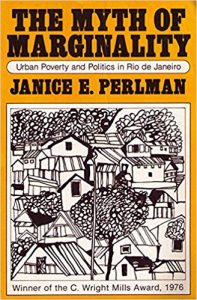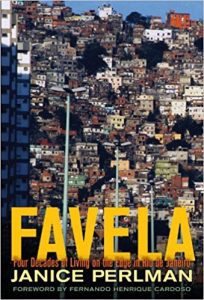The Mega-Cities Project has made a critical contribution to understanding the dynamics of urbanization through its longitudinal research in Rio de Janeiro’s favelas (Brazilian word for shantytowns or squatter settlements). Our founder and president has done immersion research, living in, conducting research in, and writing about favelas. Her longitudinal study conducted over a 50-year period is documented in The Favela Trilogy— whose 3 books are summarized here. The Mega-Cities project has also researched other topics in Rio’s favelas as seen below.

THE FAVELA TRILOGY
1. The Myth of Marginality: Urban Poverty and Politics in Rio de Janeiro
(University of California Press, Berkeley, 1976)
- In 1968-69, Perlman lived in three favelas for 6 months each and interviewed 250 people in each: 200 selected at random among men and women 16-65 years old and 50 leaders based on reputational and positional sampling.
- This research, was one of the first examples of ethnographic and survey research being done in favelas at that time in Rio. It was at the height of the Military Dictatorship. One of these favelas was eradicated in 1970.
- Perlman returned in 1973 to find out what had happened to the people who had been removed and forcibly relocated into public housing projects in the peripheries.
- At that time, she was funded by the Brazilian National Housing Bank to do an assessment of favela upgrading projects in the major metropolitan areas.
- The result of this study was published as The Myth of Marginality: Urban Politics and Poverty in Rio de Janeiro (UC Berkeley Press 1976) and in Brazil as O Mito da Marginalidade (Editora Paz e Terra, 1977)
MAIN FINDINGS and POLICY IMPLICATIONS


2. FAVELA: Four Decades of Living on the Edge in Rio de Janeiro
(Oxford University Press, 2010)
- Favela: Four Decades of Living on the Edge in Rio de Janeiro, is a book based on a follow-up study to The Myth of Marginality.
- After 30 years it seemed almost impossible to find the original study participants. The idea of a longitudinal panel study was deemed unrealistic, especially because real names had not been used and no addresses existed at the time.
- Due to the tight social ties among favela residents, we were able to find hundreds of the original study participants and to interview them and a sample of their children and grandchildren.
- After two years of searching, including visits to six other Brazilian states outside of Rio de Janeiro, we succeeded in finding 41% of the original 750 study participants. This was an extraordinary success given that our interviewees ranged from 16-65 years of age at the time of the study.
- To check for bias, we also drew new random samples of the three locations and interviewed 400 people in each plus 25 leaders.
MAIN FINDINGS and POLICY IMPLICATIONS


3. Mega-Events, Public Policy and the Future of Rio’s Favelas: Goals won and lost in the ‘game’ of the right to the city
- In 2018, we completed a three-year research project on the impact of the Mega-Events (FIFA World Cup (2014) and the Summer Olympics (2016)) on Rio’s favelas and other marginalized communities.
- The study, funded by the Tinker Foundation, covers the period from 2007 when Rio was selected to host these events through mid-2018, a year and a half after after the Olympics ended.
- The resulting book, titled The Importance of Being Gente (a person with dignity and respect), will be the third and final book of the “FAVELA TRILOGY.”

MAIN FINDINGS and POLICY IMPLICATIONS


OTHER RESEARCH PROJECTS IN RIO’S FAVELAS
- The Impact of the Pacifying Police Units in Rio’s Favelas. The UPP (Pacifying Police Units) program was initiated in 2008 by the Rio State Government to reassert control over favela territories. It involved the building of police stations in the selected favelas and 24/7 police occupation. While the first trials reduced violence, as the program expanded the result was a marked increase in violence. (See “Bringing the State Back into the Favelas of Rio de Janeiro: Understanding Changes in Community Life after the UPP Pacification Process”).
- How Real Estate Markets Work in Rio’s Favelas. This study verified the vibrant housing market in Rio’s favelas and asked the question, “How are houses in favelas bought and sold given that the owners to not have title to the land on which they are built?” (See “It All Depends: The Formalization of Informal Real Estate Transactions in Rio’s Favelas”).
- Rio’s Porto Maravilha (Marvelous Port) and its relationship to the cultural patrimony of the surrounding areas in the historic center (See “Tangible and Intangible Cultural Heritage in the Historic Center and the Port Area of Rio de Janeiro”).
PUBLICATIONS
FAVELA: Four Decades of Living on the Edge in Rio de Janeiro, Oxford University Press, 2010.
CLICK HERE TO ORDER FAVELA in Hardcover, Paperback, or ebook
FAVELA: Quatro décadas vivendo à margem no Rio de Janeiro, Editora FGV (Portuguese version) – Coming soon
Awards:
PROSE Award 2010 selection for “Excellence in the Social Sciences.”
PROSE Award 2010 selection for “Outstanding Contribution to the Field of Sociology and Social Work.”
Reviews/Interviews (partial list):
The Economist, “Shanty Life in Brazil: Onward and Upward,” July 2010.
Foreign Affairs, Richard Feinberg, May/June 2010.
Publishers Weekly, Starred Review, October 2009.
IUJRR, Review of Favela by Jacinto Cuvi, 2012.
Vitruvius, “Favelas brasileiras: do insulamento à integração na cidade formal,” Resenhas Online, Roberto
Segre and José Barki , March 2012
Berkeley Review of Latin American Studies, “Becoming Gente in Rio’s Favelas,”
Wendy Muse Sinek, Spring-Summer 2011.
The Chronicle of Higher Education, Review of Favela, June 2010.
Cities: The International Journal of Urban Research, Review by John Friedmann, 2010.
O Estado de S. Paulo, “A Primeira Gringa da Favela,” Matthew Shirts, March 2011.
Veja, “A Cidadania Ficou Para Trás,” March 2004.
Época, “Cidadania no Brasil e no mundo,” Solange Azevedo, January 2004.
The Myth of Marginality: Urban Poverty and Politics in Rio de Janeiro, University of California Press, Berkeley, 1976, Introduction by Fernando Henrique Cardoso (paperback 1979). C. Wright Mills Award 1976.
CLICK HERE TO ORDER MYTH OF MARGINALITY (English Version)
O Mito da Marginalidade: Favelas e Política no Rio de Janeiro, Editora Paz e Terra, São Paulo, Brasil, 1977.
Articles and Book Chapters
“Cities without Slums are Cities without Soul— Re-thinking Concepts and Consequences of Marginality in the Favelas of Rio de Janeiro,” Trialog 123, Other Housing Strategies, September 2017, pps 4-12.
“RIO 2016: Perspectives Beyond the Mega-Event,” Politheor Special Report, European Policy Network, International Affairs Interview, Simon Marijsse, June 29, 2016.
“It All Depends: The Formalization of Informal Real Estate Transactions in Rio’s Favelas,” in Slums: How Informal Real Estate Markets Work, Eugenie L. Birch, Susan M. Wachter, and Shahana Chattaraj (eds.), University of Pennsylvania Press, 2016, Chapter 4.
“Tangible and Intangible Cultural Heritage in the Historic Center and the Port Area of Rio de Janeiro,” in The Global Report on Culture for Sustainable Urban Development, Francesco Bandarin (ed.), UNESCO, Paris, 2016 (Launched at HABITAT III in Quito, Ecuador, October 2016.
“What Rights of Way?” Foreword to Charles Fortin’s book Rights of Way to Brasilia Teimosa, Sussex Academic Press, 2013.
“Favelas Ontem e Hoje: 1969-2009,” in Favelas Cariocas Ontem e Hoje, Editora Garamond Ltda, Rio de Janeiro, 2012.
”Parsing the Urban Poverty Puzzle: A Multi-Generation Panel Study in Rio de Janeiro’s Favelas, 1968-2008,” in Urbanization and Development: Multidisciplinary Perspectives, Jo Beall, Basudeh Guha-Khasnobis, and Ravi Kanbur (eds.), Oxford University Press, New York, 2010, Chapter 4.
“Re-democratization Viewed from Below: Urban Poverty and Politics in Rio de Janeiro, 1968-2005,” in Democratic Brazil Revisited, Peter Kingstone and Timothy J. Power (eds.), University of Pittsburg Press, Pittsburg, 2008, Chapter 12.
“Elusive Pathways Out of Poverty: Intra- and Intergenerational Mobility in the Favelas of Rio de Janeiro,” in Moving Out of Poverty: Cross-Disciplinary Perspectives, in D. Narayan and P. Petesch (eds.), World Bank, Washington, D.C.; and Palgrave Macmillan, Basingstoke, UK, 2007.
“The Metamorphosis of Marginality: Four Generations in the Favelas of Rio de Janeiro,” Annals, The American
Academy for Political and Social Science (AAPSS), 605, May 2006.
“The Metamorphosis of Marginality: Four Generations in the Favelas of Rio de Janeiro,” in Chronicle of a Myth Foretold: The Washington Consensus in Latin America, Douglas Massey, M. Sanchez, and J. Behrman (eds.), Penn State Press, 2006, Chapter 7, pp. 253-271.
“Violence as Vulnerability in the Favelas of Rio de Janeiro,” Journal of Contingencies and Crisis Management, Brian Jacobs (ed.), Staffordshire University, UK, 2006.
“The Myth of Marginality Revisited: The Case of Favelas in Rio de Janeiro – 1969-2003,” in Becoming Global and the New Poverty of Cities, Lisa Hanley, Blair Ruble, and Joseph Tulchin (eds.), Woodrow Wilson International Center for Scholars, Washington, D.C., 2005, Chapter 1, pp. 9-54.
“Chronic Poverty in Rio de Janeiro: What Has Changed in 30 Years,” in Managing Urban Futures – Sustainability and Urban Growth in Developing Countries, M. Keiner, W.A. Schmid, and M. Koll-Schretzenmayr (eds.), Ashgate Publishers, Hampshire, UK, 2005.
“The Intergenerational Persistence of Poverty: Life Trajectories in Rio’s Favelas, 1968-2002,” in Social Transformation in Brazil, Mauricio Font and Desmond Arias (eds.), The Bildner Center, City University of New York (CUNY), 2005.
“Music and Movies from Rio de Janeiro Tell the Story: Urban Poverty Then and Now,” Metro, May 2005.
“From the Marginality of the 1960’s, to the ‘New Poverty’ of Today: A LARR Research Forum,” Latin American Research Review, Peter Ward (ed.), Vol. 39:1, February 2004.
“Marginality: From Myth to Reality in the Favelas in Rio de Janeiro 1969-2002,” in Urban Informality in an Era of Liberalization: A Transnational Perspective, Ananya Roy and Nezar AlSayyad (eds.), Lexington Books, 2004, Chapter 5, pp. 105-146.
“Lessons from a Longitudinal Panel Study in Rio’s Favelas 1969-2003,” in Caroline Moser (ed.), Development Planning Unit Working Paper No. 124, Bartlett School, University College London, 2003.
“O Impacto das Políticas Sociais nas Favelas Cariocas,” Rio Estudos, no. 102, Secretaria Especial de Comunicação Social, Prefeitura da Cidade do Rio de Janeiro, May 8, 2003.
“A Dinâmica da Pobreza Urbana: Um Estudo Longitudinal em Três Comunidades do Rio de Janeiro 1969-2001,” Trabalho e Sociedade, Ano 2: No. 3, IETS, Abril 2002, pp. 21-27.
“From Favelados to Citizens” (with Flavia Sekles), UrbanAge: Global Cites Magazine, Winter 2000, pp. 34-36.
“Seis ideias errôneas sobre favelas,” Review of Municipal Administration (Revista de Administração Municipal), July-September 1987, pp. 40-52.
“Favela Removal: The Eradication of a Life-Style,” in Involuntary Migration and Resettlement: The Problems and Responses of Dislocated People, Art Hanson and Anthony Oliver-Smith (eds.), Westview Press, Boulder, CO, 1981, pp. 225-244.
“The Failure of Influence: Squatter Eradication in Brazil,” in Politics and Policy Implementation in the Third World, Merilee Grindle (ed.), Princeton University Press, Princeton, NJ, 1980, pp. 152-171.
“Rio’s Favelas and the Myth of Marginality,” Politics and Society, Vol. 5, No. 2, 1975, pp. 131-160.
“Methodological Notes on Complex Survey Research Involving Life History Data,” Monograph No. 18, Institute of Urban and Regional Development, Berkeley, California, October 1974.
“Dimensões de Modernidade Numa Cidade em Franco Desenvolvimento: Estudo de Caso de Belo Horizonte” (Dimensions of Modernity in a Developing City: Case Study of Belo Horizonte), Revista Brasileira de Estudos Políticos, November 30, 1971.
“Seis ideias errôneas sobre favelas,” Review of Municipal Administration (Revista de Administração Municipal), July-September 1987, pp. 40-52.


